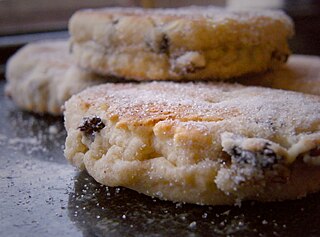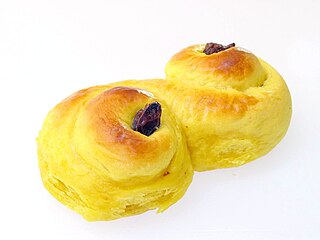
Zante currants, Corinth raisins, Corinthian raisins or outside the United States simply currants, are raisins of the small, sweet, seedless grape cultivar Black Corinth. The name comes from the Anglo-French phrase "raisins de Corinthe" and the Ionian island of Zakynthos (Zante), which was once the major producer and exporter. It is not related to black, red or white currants, which are berries of shrubs in the genus Ribes and not usually prepared in dried form.

A scone is a traditional British baked good, popular in the United Kingdom and Ireland. It is usually made of either wheat flour or oatmeal, with baking powder as a leavening agent, and baked on sheet pans. A scone is often slightly sweetened and occasionally glazed with egg wash. The scone is a basic component of the cream tea. It differs from teacakes and other types of sweets that are made with yeast. Scones were chosen as the Republic of Ireland representative for Café Europe during the Austrian presidency of the European Union in 2006, while the United Kingdom chose shortbread.

Fruitcake or fruit cake is a cake made with candied or dried fruit, nuts, and spices, and optionally soaked in spirits. In the United Kingdom, certain rich versions may be iced and decorated.

Bara brith is a traditional Welsh tea bread flavoured with tea, dried fruits and spices.

Welsh cakes, also bakestones or pics, are a traditional sweet bread in Wales. They have been popular since the late 19th century with the addition of fat, sugar and dried fruit to a longer standing recipe for flat-bread baked on a griddle.

A teacake in the UK is generally a light yeast-based sweet bun containing dried fruit, typically served toasted and buttered. In the U.S. teacakes can be cookies or small cakes. In Sweden, they are soft, round, flat wheat breads made with milk and a little sugar, and used to make buttered ham or cheese sandwiches. In India and Australia, a teacake is more like a butter cake. Tea refers to the popular beverage to which these baked goods are an accompaniment.

Raisin bread or fruit bread is a type of bread made with raisins and flavored with cinnamon. It is "usually a white flour or egg dough bread". Aside from white flour, raisin bread is also made with other flours, such as all-purpose flour, oat flour, or whole wheat flour. Some recipes include honey, brown sugar, eggs, or butter. Variations of the recipe include the addition of walnuts, hazelnuts, pecans or, for a dessert, rum or whisky.

A saffron bun, Cornishtea treat bun or revel bun, is a rich, spiced yeast-leavened sweet bun that is flavoured with saffron and contains dried fruit including currants and raisins similar to a teacake. The main ingredients are plain flour, butter, yeast, caster sugar, currants and sultanas. Larger versions baked in a loaf tin are known as saffron cake.

Barmbrack, also often shortened to brack, is a yeast bread with added sultanas and raisins. The bread is associated with Halloween in Ireland, where an item is placed inside the bread, with the person receiving it considered to be fortunate.

Lardy cake, also known as lardy bread, lardy Johns, dough cake and fourses cake, is a traditional spiced bread enriched with lard and found in several southern counties of England, including Sussex, Surrey, Hampshire, Berkshire, Wiltshire, Dorset and Gloucestershire, each claiming to be the original source. It remains a popular weekend tea cake.

Genoa cake is a fruit cake consisting of sultanas, currants or raisins, glacé cherries, almonds, and candied orange peel or essence, cooked in a batter of flour, eggs, butter, and sugar.

A rock cake, also called a rock bun, is a small cake with a rough surface resembling a rock. They were promoted by the British Ministry of Food during the Second World War since they require fewer eggs and less sugar than ordinary cakes, an important savings in a time of strict rationing. Traditional recipes bulked them with oatmeal, which was more readily available than white flour.

Dundee cake is a traditional Scottish fruit cake.

Northern Irish cuisine encompasses the cooking styles, traditions and recipes associated with Northern Ireland. It has distinctive attributes of its own, but has also drawn heavily from Irish and British cuisines.
Bread is a staple food throughout Europe. Throughout the 20th century, there was a huge increase in global production, mainly due to a rise in available, developed land throughout Europe, North America and Africa.

Welsh cuisine encompasses the cooking styles, traditions and recipes associated with Wales. While there are many dishes that can be considered Welsh due to their ingredients and/or history, dishes such as cawl, Welsh rarebit, laverbread, Welsh cakes, bara brith and Glamorgan sausage have all been regarded as symbols of Welsh food. Some variation in dishes exists across the country, with notable differences existing in the Gower Peninsula, a historically isolated rural area which developed self-sufficiency in food production.
Kletzenbrot is a sweet bread with dried fruits, especially dried pears made for the Advent season in some Christian countries, notably associated with the Austrian state of Tyrol, and sometimes called Tyrolean Dried Fruit Bread. Modern varieties are usually made with dried fruits and nuts like walnuts, raisins, currants, dried apples, figs and prunes. Most recipes add spices like cinnamon, cloves, anise, nutmeg, and rum for extra flavor. There are many possible varieties of the loaf, which is sometimes made with rye flour for a dark brown loaf, but can also be made with whole wheat flour. The flour can either be just incorporated in the dough with the dried fruit or it can be used to make an extra dough coating.














